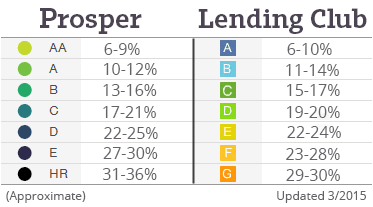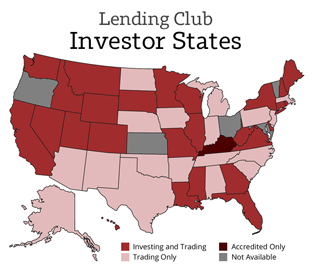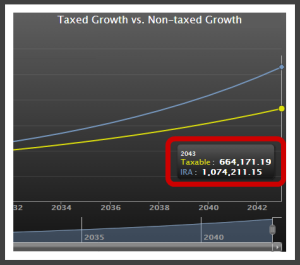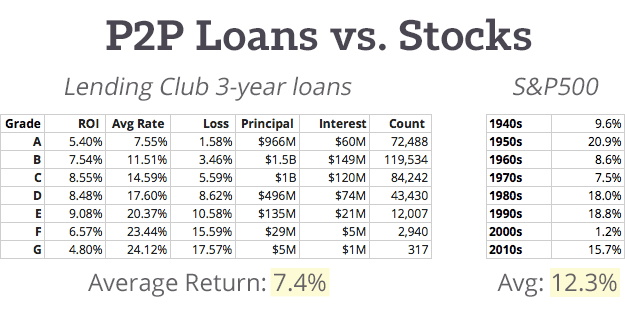It’s probably pretty obvious to visitors of this site that I’m a fan of lending money online. A significant portion of my week is dedicated to reading, writing, and having conversations about p2p lending. I’m so convinced, I’ve even suggested investors put 20% of their excess cash into this investment.
That said, a number of problems remain. Peer to peer lending continues to be a niche investment in the US. Despite millions of people actively saving for retirement in stocks and bonds, only a tiny fraction invest in consumer loans.
Even the Cunninghams Aren’t Doing It
This problem is best illustrated by my own family situation. Neither my parents, siblings, nor in-laws are investing in peer to peer loans. You would think having a peer to peer nerd as a son/brother would make it happen. Yet years later, I am the only one in the group who is involved.

Here’s the thing: my family is awesome. They are a bunch of smart, generous, fun-loving crazies who are up for anything, including novel ways to make money. For example, as a family we planted thousands of pine saplings in our backyard to sell later as Christmas trees. We bought them for 10 cents, eventually selling them for $50 each. Talk about a great investment.
If the Cunninghams aren’t getting involved, something else must be going on. My hunch is that their reasons are typical for millions of other Americans nationwide. As a result, I phoned ’em up and asked them about it.
7 Problems that Stop People from Lending Money Online
My family gave me a lot of food for thought. Combined with other opinions in the industry, here are the biggest reasons why people aren’t involved in peer to peer lending.
Biggest issue: Many Americans don’t invest at all
There is a coming crisis headed for our country. Fifty percent of Americans say they can’t afford to save for retirement, much less invest at Lending Club or Prosper. In fact, the anxiety people feel around retirement is greater than any other financial problem they have, including sending their kids to college or paying for housing. (see Gallup). Thankfully, my family is not in this category.
If you aren’t saving anything for retirement, you need to stop reading this article. Call in sick to work, draw the blinds, and watch The Retirement Gamble by PBS.
Issue #2: Peer to peer lending is a self-directed investment with a learning curve
The biggest roadblock cited by my family? You have to do it yourself.
Most Americans don’t fix their own cars or tend to their own medical issues, so why should people have to manage their own financial portfolios? Instead, my family just has their employers manage their retirement so that they can focus on other things. And the truth is, most Americans do that too — investing through third-parties like an employer’s 401k. More often than not, this works fine (though most end up paying over $150,000 in fees).
Peer to peer lending has gotten simpler over the years (e.g.: Prosper ending their auction system). However, it still remains pretty complicated for the average Joe. The main complicators: choosing loan grades and diversifying in 200+ notes.
 Choosing loan grades – A new investor needs time and patience to understand what ‘grades’ are, self-assessing their own tolerance of losing money to bad loans (see: What Grades Should I Choose?).
Choosing loan grades – A new investor needs time and patience to understand what ‘grades’ are, self-assessing their own tolerance of losing money to bad loans (see: What Grades Should I Choose?).- Diversifying in enough notes – A new investor needs time and patience to understand what a ‘note’ is, and how spreading cash across hundreds of these notes keeps things more predictable (see: Diversifying your Account).
This problem is most obvious by looking at Lending Club and Prosper’s websites. Both require people to manually select their own loan grades while also needing them to manually diversify across enough notes. Can you feel the new investors getting overwhelmed? This stuff is just too heady for most people.
Eventually, these loans will be a part of funds that financial groups can allocate into employer plans and 401(k)s. But for now, p2p lending appeals to the self-directed.
Issue #3: Many states do not allow peer to peer lending
 My family is from Michigan, which is closed to Lending Club (though open to Prosper). They are not alone in their limitation. A large portion of our national population lives in states that do not allow peer to peer lending at all (e.g., Ohio and Texas). The financial regulators in these states have deemed this investment as too risky, so millions of people have no access.
My family is from Michigan, which is closed to Lending Club (though open to Prosper). They are not alone in their limitation. A large portion of our national population lives in states that do not allow peer to peer lending at all (e.g., Ohio and Texas). The financial regulators in these states have deemed this investment as too risky, so millions of people have no access.
Thankfully, Lending Club’s IPO should open up more states with time (through a Blue Sky exemption). But for now, half the nation can’t even open an account. See: What States are Open to Lending Club & Prosper?
Issue #4: The minimum investment is too much money
When I first began peer to peer lending in 2011, I opened up a Lending Club account with just $1000 in 40 $25 notes. I wasn’t diversified at all. This is because a $1,000 trial investment was all I could spare, and looking back you can see diversifying across just 40 notes was like playing with fire. Thankfully, I had a positive experience.
For most though, the fact remains that a $2,000 trial investment at Lending Club or Prosper is just too steep. Most people don’t try anything with $2,000. What parent gives their middle schooler a $2,000 saxophone on the first day of band class?
Issue #5: The returns are not as good as the stock market
Most people are interested in long-term investments, and over time this investment is easily beat out by the stock market.
Above you can see every 3-year loan issued since Lending Club gained approval from the SEC in 2009. To the right I’ve listed the much larger average return of the S&P500 index (source). 75 years of stock market earnings easily outshine Lending Club’s past six years of issued loans.
Peer to peer lending’s current 7% return, while notable and consistent, is not really a headline-maker. If it had instead returned something like 10% per year to all its investors, there would be greater popular buy-in. For now, the stock market remains the king of returns.
Issue #6: The 1% investor fee is not exceptional
New investors might be interested to hear I’ve taken a $20,000 investment and earned $6,800 in interest over the past few years. But fewer are aware that I’ve paid $184 to Lending Club in fees, 1% per year.
Vanguard has fees as low as 0.05% per year, a twentieth of Lending Club’s cost.
In contrast, investments in stocks and bonds through a company like Vanguard commonly have fees as low as 0.05% per year, a twentieth of Lending Club’s cost. The reason they can do this is because Vanguard’s funds are so popular. The massive number of investors means every person pays a smaller share of the costs.
That said, the central reason why Lending Club and Prosper are doing so well is because they operate completely online. Without branches or tellers like a bank, their cost of business is a fraction of a traditional lender. However, investors like myself have not experienced this benefit in the form of lower fees. Compared to other investments throughout the country, peer to peer lending is not much cheaper to do, another non-incentive for America’s money managers.
Issue #7: Taxes at Lending Club and Prosper can be a burden
 Taxes can be expensive: Investing in the stock market is so deeply woven into the fabric of the United States that it gets its own special tax rate: just 15%. By comparison, investing at Lending Club or Prosper has the same tax rate as interest earned from something like a savings account. If you’re in the 30% tax bracket, you will lose 30% of your p2p earnings to taxes. Of course, you can lessen this issue with a tax-incentivized IRA, but most don’t do this.
Taxes can be expensive: Investing in the stock market is so deeply woven into the fabric of the United States that it gets its own special tax rate: just 15%. By comparison, investing at Lending Club or Prosper has the same tax rate as interest earned from something like a savings account. If you’re in the 30% tax bracket, you will lose 30% of your p2p earnings to taxes. Of course, you can lessen this issue with a tax-incentivized IRA, but most don’t do this.
Taxes can be confusing: Defaulted principal is typically classified as capital losses while recovered principal is seen as capital gains. Further, the paperwork can be tedious if you’re active on the Foliofn secondary market (though most are not).
P2P Lending is Still a Remarkable Investment
Yes, there’s a learning curve. And yes, this investment doesn’t earn a higher return than the stock market. However, it still offers some incredible benefits:
- Typically earns 5-9% and has never had a negative year
- The chance to diversify your savings across another asset class (perfect compliment to stocks and bonds)
- A passive investment (via automated tools)
- A meaningful way to invest that sets borrowers free from debt
Read about these benefits in-depth here: What is Peer to Peer Lending?
I finally got my parents to open an account
While talking to my dad about this article, he realized he has a small IRA that he opened in the 80s, but which hasn’t been touched in decades. There isn’t much money in it, so he thought, “This is a perfect little lump sum for a trial investment. Why don’t we move it into peer to peer loans so I can see what all this fuss is about?”
Mission accomplished.
What do you think? Are there any problems I missed?
[image credit: ‘beacon‘ by Mitchell Haindfield CC-BY 2.0]



That is awesome that you got your dad to finally give it a try.
I finally initiated a transfer of some new funds over to my prosper account this morning. Time to get that thing moving again. Your articles have definitely kicked me into action.
Cheers!
Glad to hear it GYFG. Your stuff has definitely adjusted my practice as well.
Nice article as always Simon. I think another problem many people have is that they believe it is too risky. I mean, we are talking unsecured consumer loans here. In the next recession they are going to get hammered and I will lose all my money. Or at least that is the thinking that I hear from time to time (obviously I disagree).
Thanks Peter. Great point. The misperception of insecurity in this investment is definitely a factor. A part of me is almost rooting for a national recession just so this critique will die away.
That is what Samir Desai, the CEO of Funding Circle, said at LendIt Europe last year: a recession will be the making of this industry.
I’d say the reasons include:
1. Not included in 401(k)s, which is where most people invest
2. There is no money in it for the average advisor who works on a commission basis or is tied in with a brokerage house on an “assets under management” basis. My financial advisor had barely heard of p to p when I mentioned it to him
3. Hard to quantify returns, or to decide to what to compare them. Performance doesn’t equal stocks on the upside; and isn’t as safe as banks on the downside. If you play around on NSR looking at completed loans the returns don’t look nearly as high as what people are touting. There is lots of statistical data available on diffrent sites but you have to know math than I do to follow it.
4. You have to buy it on the internet, which means you have to send your money to a company you’ve only seen on the web, a company none of your friends do business with, and all you get back is numbers on a screen. Considering that the website says you are required to have an annual income of $70,000 and a net worth of $70,000, your potential investors are a little skewed toward older people, who are less comfortable with web-based businesses.
5. It isn’t allowed in so many states. Besides keeping people in those states from investing, the prohibition makes others wonder if there is something fishy going on.
Solid reasons. Thanks RtR.
I’d only dispute the idea that there’s no money in it for advisors. LendingRobot, for example, just got a nice round of venture funding while charging .45% for assets under management. Those in brokerage houses could imitate this model (adding a layer of fees for account management).
Sure, they could, and if their customers demand it–if the customers start hiring your company to manage major portions of their assets, keeping that money out of the hands of the advisors, I’m sure they’ll adapt and do just that. However, right now, I think you’ll find that most p to p investors are those who learned about the investment on their own and made their own decision about how much to invest, and how agressively, even if they do end up hiring you or your competitor do handle the details for them.
Aptly written article as always Simon, thanks for always so thoughtfully illuminating the issues. I am wondering whether p2p lending companies are lobbying state legislations to loosen the rules so that more individuals can participate. Using the secondary market is far more challenging and time consuming, it seems to me, than investing directly through LC and similar companies.
Curious also what are the trends worldwide – I know p2p lending is gaining momentum in Europe. Perhaps eventually it will become more mainstream as more experience is gained across a variety of conditions and economies.
Regarding IRA’s with p2p companies, what is your view on any limits that an individual might encounter in the future (a good problem to have but still :) ) Say someone has been investing in an IRA with a p2p lender for 35 years and they are trying are trying to place 100’s of thousands into notes – do you see a challenge in that? Current LC policy is that they want to talk to you individyually if you are investing a very large amount.
Another thought… Given the challenges with taxation – both complexity and taxation level – p2p lending investing is best suited for IRA’s. That is particularly salient when you consider that the average return that retirement planinng projections quote is 7 or 8%.. in the ball park of what p2p so far has as a record. But what retirement advisors don’t emphasize is that this is an average with large variations over potentially large time periods. So you may end up with an average of 12% in a mutual fund, but when you want to retire it may be down 30% and you are out of luck. If p2p lending can demonstrate a significantly better stability of returns at that level, I think it will be a winner. I very much want it to be.. as I am just getting started with an IRA with a p2p lender.
What are the restrictions on a US citizen lending on P2P sites if they live overseas?
I second that question. Also, if you move from a state like CA that allows investing in original notes to a state like Texas that does not – can you continue investing in original notes??
Hi Milen. I don’t think so.
Hi Sol. Great question to ask Lending Club by phone. I’m curious to hear their answer myself.
I find that a lot of people I talk to about P2P are either very skeptical or simply don’t have any idea what it really is about. A lot of education is needed. I was at a recent conference with some pretty smart real estate investors in California – and, when I brought it up, they shrugged it off as a novelty or to trivial for real investment dollars.
A lot of people don’t save at all (about 30% worldwide, according to HSBC Report), many are paying of debt or mortgages (especially in the US).
When they do save, they start with an emergency cushion and 401K (which makes sense). It will take a while to get to a 3-6 month emergency fund and to max out your 401K. Add all the reasons you list above and you get to a very small percentage of people getting into P2P…
Simon, I really enjoyed the article. A really interesting concept of 40 Act Fund that Prosper are trying to deal with. Making an easier solution for the advisors is a really powerful business model. As always thanks, Glenn
Thanks for stopping by Glenn
Can a p2p account be set up as a revocable trust fund?
Great article. I’m averaging 7.22% over the last three years. Their averages are right on que. I’ve come across a realization as of late. It’s a pretty obvious one but non-the-less, I still realized it for the first time. That is, my money is gone, spent and never coming back. All I get in return is a monthly dividend check. With my Roth IRA, I could withdrawal that money at any time (with fees and taxes) but non-the-less, I can pull the money from the account. With peer to peer Lending however, the money is already spent and I have to hope my recipients keep the checks rolling in. To be completely honest with myself though, not being able to pull the original lump sum back out is actually a good thing, a security feature for my impulsive withdrawals that has happened with my previous Roth account. If you can’t touch the money, you will be forced to invest for the long run and forced to earn compounded interest and account growth, something I probably couldn’t control on my own.
Great comment. Thanks for sharing, Jason.
considering funding my account on lending club. from what I have seen with working through the site. you are going to get a better return than a basic savings account. even though your money is tied up for 3-5 yrs with the notes you are buying. I have seen you can set your custom automated note purchasing to any percentage you would like. by doing this it will also keep you liquid if for some reason you would like to retrieve some cash quickly. called the site yesterday to confirm there are no fees for transferring your money from your lending club account to bank account linked to your account. still looking into the site. have some questions about the taxes and reinvestment of interest gained.
That is good, just know that returns have been steadily dropping in the last two years. I’ve had an account for close to 3 years, and in the last year alone returns have gone from 8.5% to barely holding on to 7%, with a steady trend DOWN. If it gets to 6% I’m out. I use an IRA, otherwise paying full income tax on these returns, plus the headache of accounting for your losses in your tax return, plus not having liquidity but carrying substantial risk – would be too much. Not to mention you have a cash drag that will probably decrease you return by some degree further.
I’ve been only reinvesting manually, using very strict filters. I target only C and B loans, and my filters return only A, B or C. Most of the time I don’t even get anything that matches my filters, but when I do, I see almost no discernible difference between an A grade and a C grade. I look at the job descriptions in the loan listing and the other info there, and often what I consider a safer note (low carrying credit balance, low credit utilization, high income, normal sounding job, as opposed to bullshit like “CEO”, “Director” making 70K and renting) is rated C, and something with the same credit score and worse reading on those things is rated A. When I see stuff like that, it tells me that Lending Club’s algorithm has become shit, or it has always been shit and I didnt notice until I started investing manually.
Another anecdote: on a loan listing I noticed the state was listed as “606xx, CA”. I checked and there is no zip starting with 606 in CA, nor is there a CA zip starting with 906, if you assume it was a typo. There is a zip starting with 906 in Michigan and one starting with 606 in Illinois. I emailed Lending Club about it and they responded that it was likely a typo. I don’t buy it because no one would make a typo with the state letters if they lived in MI or IL and no one would make a DOUBLE typo if he/she lived in CA. So my conclusion was that that load was bullshit and Lending Club didnt care.
I started off very enthusiastic as an investor in the Lending Club stock as well as the notes. But today I am on the verge of dropping both, as I am starting to have doubts not only about the quality of note underwriting (I can’t imagine a bank being this sloppy), but about the viability of the company itself after 4 quarters of losses.
So, word to the wise.
Would like to read all of your thoughts on a relatively new player in this arena called Peer Street.com ….only do residential and commercial RE lending…..no, your investment is not secured by the RE but they are only doing 1st mortgages, no seconds, and do not invest if requested loan exceeds 75% LTV. Seems to me to be a much better option then the sites you mention here that are putting out all kinds of unsecured loans.
Peer Street investors must be an accredited investors…income >$200K or $1M net worth
A more insightful article:
http://www.financialsamurai.com/how-i-earn-over-10-passive-income-with-p2p-lending/
Oh and your S&P 500 calculations are off, you’re not taking in to account inflation and today’s money, the average return for the S&P over that span is about 7.22% when considering that.
Thanks for the article. I came here after noticing while trying to sign up for Prosper and Lending Club that I was ineligible on penalty of perjury based on the fact that my annual income isn’t currently 70k or more. I just started in a new industry. I want to invest, but I don’t want to be a liar, so for now, I can’t.
What’s crazy to me is that poor people and median income people making under 70k can blow tons of money on government sponsored lotto tickets while the gov. prevents them from investing with integrity in an excellent investment that has a lot better chances of making you $ relatively consistently as you invest diversely within P2P lending.
I don’t understand why you can’t invest if you don’t make $70k a year AND have at least $70k in assets.
How are people supposed to grow their net worth if they are prevented from available avenues to make their money work for them?
Seems that lower earners are being economically disadvantaged by these rules. Why are the poor relegated to buying lottery tickets when they have a MUCH better chance seeing a return on their discretionary spending through investment?
Doesn’t really make any sense to me….
Exactly!!!! I want to invest in P2P so bad, but I simply don’t make enough money (about 30K short) to invest in P2P….
I totally agree with the above comments re. income requirements for p2p investors. It’s intentionally exclusionary to large groups of people. On its face it’s a straightforward concept, and something you’d become better with in time. Hence, the idea that it’s too complicated for novice investors to grasp is ridiculous.
I would really appreciate a sensible explanation as to why the income criteria exists. Otherwise, it’s simply discriminatory without reason.
Hi C. I assume it’s there to stop people from investing more than they can afford to lose. So if somebody is making $20,000 per year, then a diversified investment of 200 notes ($5,000) would be way more than they can afford. Literally they can’t afford to diversify, and so they shouldn’t invest.
I put 2,500 into LC kind of “for fun” a year or so ago. I realized about 7% in 2015- not bad considering this is money I likely would have had in a bank account earning virtually nothing. I am concerned about how you get your money out [Jason’s comment from Sept. 2015] but my understanding is that if I change it from having my cash automatically reinvested to have it left in cash, that as the notes are paid off, my cash balance increases and then I can ask for a check. OR, you can apparently sell the open notes on a secondary market. That sounds a little scary to me because there would likely be a discount required in order to sell them. Anyone else have any experience in withdrawing your money from Lending Club? Also, what are the potential tax issues?? I just figure that any increase in the value would be considered interest income. I might even invest more if I was comfortable in the liquidity of my Lending Club investment.
“….Anyone else have any experience in withdrawing your money from Lending Club? Also, what are the potential tax issues?? I just figure that any increase in the value would be considered interest income. I might even invest more if I was comfortable in the liquidity of my Lending Club investment.”
Don’t know how you sell Lending Club notes. You can sell your Prosper notes on a Folio web trading site. Yes… If you want to sell in a hurry you’d have to sell at a discount. In short, peer-to-peer investments are not very liquid.
If you sell your notes as a loss you get some tax advantages. If you sell them at a gain it is not treated as “interest” but as capital gains… which is usually taxed at a much lower rate. Sometimes as low as zero percent.
I have spent 25years in the lending industry. it is my understanding there is zero verification and oversight on these loans. You folks need to watch/read “The Big Short”, then watch/read it again, take notes, then watch it again. Perhaps you will be enlightened to the real story here… I wouldn’t invest $1 in the these junk investments.
You are entitled to your own risk tolerance… But it is not true that\\\’s there is \\\”zero verification \\\” on the borrowers.
I love the concept and the idea. But you are right I almost gave up recently on it because managing it became “boring”. Instead I opted to try out LendingRobot under the free first 10,000 dollars to see how it goes. So far P2P only consists of less than 1% of my investable assets. Going into the my 3rd year on the platform… I still have mixed feelings about it. Al though the returns have actually beat the markets performance during 2015 and so far this year, but then again thats too short of a time frame to make any real conclusions. For now, I am in the lets see what happens in the future. I hope to see better results, better options to have some more automated systems to self manage the accounts like lendingrobot and few other companies.
Most people simply don’t spend enough time studying investing. That leaves opportunities for the rest of us.
Useful relevant write up.
Here’s IMO two inhibitors you missed:
It’s very difficult to assess the degree of RISK in having X percent of one’s nest egg in Prosper (or any P2P).
I’ve had over 1000 fractional loans for two plus years , and Prosper calculates my predicted defaults. And I’m actually doing much better than the predict. ( My ROI is over 11%.)
But no one knows what impact on default rates in P2P would be if the whole economy melts down. (True…your mutual fund and most traditional investments would suffer massively deeply in that case too…unless you’ve been heavily hedged or shorting because your crystal ball reliably predicted the depth AND timing of the meltdown.)
What if Prosper itself implodes?
I personally view my Prosper portfolio as pretty low risk…particularly for something yielding 11%+. But a clearly well intentioned advisor at JP Morgan ….who was NOT telling me to take my money out of Prosper…classified it as “high risk.”
The other barrier is liquidity:
if you put $10,000 or $100,000 in a mutual fund and suddenly need or want half yiu can get that cash out very fast. Maybe even loan against it. Prosper you MIGHT be able to liquidate it on Folio in a week if willing to sell at 4% discount. And at best more complex than picking up the phone and saying “sell half my Prosper holdings.”
Great article. I’ve been in Lending Club since 2008. Started slow, even took money back out to see if it was real. LC got some good press and I continued to put small money in. Over the years I’ve increased my position up to the $100K I have in there now. Late 2014 I also started contributing to Prosper and have almost $75K in there.
I’ve been getting 7-10% interest since the beginning, and have collected well north of $20K in interest total so far and get over $900 per month now (I’ve just recently substantially increased both accounts, so the interest has not yet caught up). This may not beat the stock market over the long haul but it sure has in the short term. I already contribute the max (along w/ a 4% match from my company) to my stock and bond based 401k, and invest in another brokerage account. I have far more at risk in stocks than P2P. I have a real estate mortgage as well. This means that my P2P gives me true diversification and, as noted in the article, it’s never had a down year.
I feel like I am a pretty typical, conservative investor and the P2P just makes sense to me. Look at the money the big banks are hauling in year after year – with a lot of it coming from prime consumer credit.
At some point I will stop contributing, and will then let my loans pay back over 3-5 years to get a very handsome cash flow, along w/ the interest as the balances subside. Over the years I have lost plenty in my Edward Jones account (since closed) and my 401k seems to not do as well as it should year after year so I really appreciate the balance my P2P accounts give me.
Hi Simon,
What is your impression on P2P lending regarding the liquidity of your investment? I understand that you can sell your notes on secondary company (folio) but I have run into a problem before where it took me months (or maybe a year+) to completely sell all of my notes. This happened when I tried to deplete my investment from Prosper to move over to Lendingclub.
Han
The platform is fairly liquid if people know how to work Folio. Otherwise, most are probably wise to just stop automatic investing and take the cash balance as it accrues. Taking months to sell all your notes on Folio sounds pretty accurate. LendingRobot.com actually has a great sell tool if you need to do it quicker, but they’ll charge a small amount for the service.
I did a small experiment to see how liquid holdings at prosper are.
. I put about 12 randomly chosen notes on Tonio and offered to sell them the 1% discount .
I think 6 sold. Some less than a 1% discount. That is people bid them higher.
That was in one week. If I left the other six for sale or a couple more weeks, who knows?
But if , as you say here,you tried to liquid find your total home things, and found that it took many months to do that, I would give you larger experiment more credibility.
Do you only important question I have for you, about your experience in selling, is did you offer to sell them at a discount? If so how much? Or did you hold out for the full face value on each of your existing notes?
Reason, that makes a big difference, is this:
If you were unable to sell the notes in less than a year despite willing to take whatever was often that’s one thing. That papers and notes very illiquid. If on the other hand if ,for example, you could have sold slmost all of them them quickly at a 2% discount…I,d call that pretty liquid. Different comfort level.
Alex
Unfortunately, prosper discontinued the connection to the folio trading platform about half a year ago. So at this time prosper investments must be considered very UN-liquid . Only way to get your cash out is turn of all reinvestment and wait for the loans to mature. This could take as long as five years to get your last dollar out. As far as I’m concerned this makes lending club hey superior alternative to prosper, and I’m going to start getting my funds out.
I appreciate your answer Simon. However, it doesn’t address the idea of someone with an income of three times as much (but still shy of the one 70/75k income minimum) wanting to get involved. It’s likely that a single person with no dependents and few expenses could reasonably afford a 5k investment. So, to me it would seem that the cap excludes a fair number of people who’d be able to do so comfortably. I simply don’t see a good reason for the restriction.
Hi great article! Just read this years later and it’s still relevant. However I have heavily invested in LC about 50k I do have to say it is a worth while investment as I averaged about 7% return. Only caveat is that when tax come around your losses don’t deduct on your gains. A huge loss in potential profit. I did hear of this idea of starting a business entity to offset losses with gains, has anyone heard of this? TAXES seems to be the big issue for me otherwise this is a solid alternative investment.
Regards to the Cunninghams. Love the story!
Jamos
Hi,
I am very interested in investing in peer to peer lending. My issue is that I can’t find a platform that will take my Solo 401k trust money. So far prosper and lending tree. are a no go. Any other options you can suggest?
Thanks
I’ve been involved with Prosper for about 3 years, but am moving all my investments (as fast as they mature out) to Lending club.
In Short:
1) Prosper got rid of the trading platform, which makes Prosper investments COMPLETELY not liquid. If you need to get your money out it could take as much as 5 years before your last dollar comes out. Lending club does have the Folio trading platform… making investments there semi-liquid.
2) Lending club seems to be doing a better job of vetting their borrowers, so my yields there are a bit higher than they were/are at Prosper.
3) For quite a long time Prosper dad been incorrectly very significantly reporting my percent rate of return as higher than it really was… until they finally discovered their error.
Anyone figured out Upstart.com taxation? They only issue a 1099-INT, and it’s for the full interest you received, with no figuring of charged off loans. So you could receive a little interest from a loan, then the whole loan could be charged off – and they’re reporting to the IRS that you still made money on it! My total interest received is DOUBLE my actual income due to the charge offs and fees. CPA says investing fees cannot be deducted anymore. The fees are not huge. But the charge offs are huge. I’ve heard they’re “capital loses” capped at the $3,000 which doesn’t help. Instead of paying 22% tax on my 6.5% returns, I could be looking at 44% since they’re doubling my reported income !! Total insanity. Do I just fat finger in my actual year end statement based income into the 1099-INT and wait to explain this in tax court?
I’m famikiar with the serious tax mistreatment issue on on high apparent , but not real, ROI that can and usually does occur at Prosper , Lending club, and presumably and how their peer to peer investment platforms.
In short, one can easily, for example end up paying stadard earned interest tax rates on a $20,000 gross and income, when due to losses on defaulted loans one’s true return is, say, $5000 net. And in many investors’ tax picture it appears that there’s no place to “use” more than $3000 of the very real losses to correct what in reality is Inappropriate over taxation have a modest return on investment.
However, after discussing and analyzing this with my tax accountant/attorney he found a creative place on my return to deduct (not as itemized deduction, nor as a passive semi useless loss on schedule-D) full reported losses reducing my AGI consistant with the real loss.
In short, it is sometimes possible to either enter the defaut losses in the IRS expected place, enter an other line under “other” Or “adjustment” adding in back into there reducing the passive loss…. but with a note something like “thransfered to line XX of Schedule-xxx (or Form nnn)
In short, you might do well to find a more effective tax preparer, or work more sith yours,, if in that situation.
Yeah, Viktor, this is one thing the cheerleaders don’t tell you. Lending Club is better in that regard, I havent heard of Upstart – but based on your post, I am better off that way.
I was a believer once in p2p unsecured lending, but when I saw 1) Lending Clubs cavalier attitude and how they ignored my alerts that some note postings were clearly erroneous at best and fraudulent at worst, 2) the rising number of defaults to 2-3 times the average in the credit card industry in a GOOD economy, and 3) my returns dropping from ~8% to ~4% — well, what is the point of wasting your time with this business model. Not to mention the tax issues and headaches especially if you scale and itemize everything, and the serious liquidity constraints….If I could make reliably 7-8% return, I would put up with this, but for 3-4% a step away from crashing to negative if default rate goes up slightly – you gotta be kidding me.